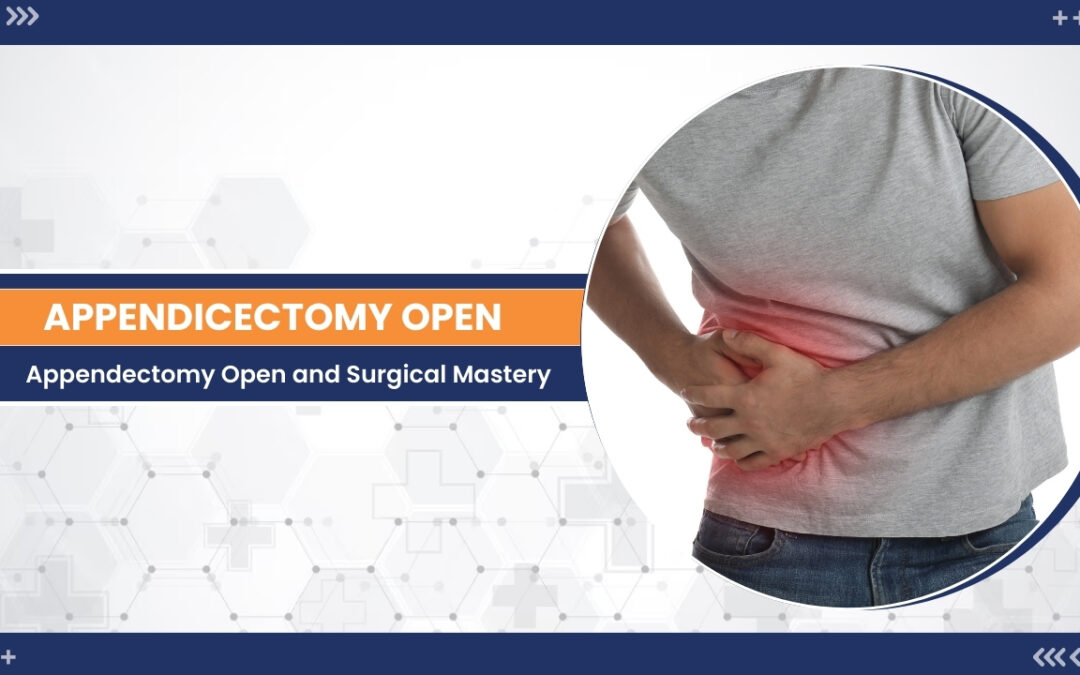Introduction to Appendectomy Open
Appendicitis, a common and often painful condition, has historically been met with the trusted method of “Appendectomy Open.” As we embark on this exploration of open appendectomy in this blog, we unravel the layers of this traditional surgical approach. Acknowledging the significance of appendicitis treatment, we delve into the procedural intricacies, uncovering how skilled surgeons navigate through the challenges posed by an inflamed appendix. This journey through open appendectomy will not only illuminate the step-by-step process but also highlight the distinct benefits it offers. Whether you’re seeking insights as a patient or are part of the medical community, our aim is to provide a comprehensive understanding of open appendectomy, enabling informed discussions and decisions surrounding this time-tested surgical intervention.
Appendectomy Open
What is Appendectomy Open?
Symptoms of Appendicitis:
- Abdominal Pain: The most common symptom is pain around the navel that gradually shifts to the lower right abdomen.
- Nausea and Vomiting: Appendicitis can cause nausea and vomiting, often accompanying abdominal pain.
- Loss of Appetite: Individuals with appendicitis may experience a reduced desire to eat.
- Fever: A low-grade fever may be present due to the inflammation of the appendix.
- Changes in Bowel Habits: Constipation or diarrhea may occur as a result of appendicitis.
Causes of Appendicitis:
Appendicitis is often caused by the blockage of the appendix, leading to infection and inflammation. The blockage may result from:
- Fecal Obstruction: Hardened stool or foreign particles can block the opening of the appendix.
- Enlarged Lymphoid Follicles: Infections can cause the lymphoid tissue in the appendix to swell, leading to obstruction.
- Tumors: Rarely, tumors in the digestive tract can cause blockages.
- Worm Infestation: Parasites or worms can contribute to blockages, although this is less common.
It’s important to recognize these symptoms promptly, as untreated appendicitis can lead to complications such as a burst appendix, which can be life-threatening. If symptoms arise, seeking medical attention for proper diagnosis and treatment, including the potential need for an open appendectomy, is crucial.
Indications for Open Appendectomy:
Open appendectomy is employed under various circumstances dictated by the complexity of the case and specific patient factors. When faced with severe inflammation, extensive infection, or complications associated with appendicitis, surgeons may opt for open appendectomy as laparoscopic surgery becomes less suitable. This approach is particularly favored in cases of complicated appendicitis, where a perforated or gangrenous appendix requires meticulous visualization and thorough cleaning of the abdominal cavity.
Uncertain diagnoses can also lead to the choice of open appendectomy, allowing surgeons to carefully inspect the appendix and surrounding tissues for a definitive conclusion. Obesity and a history of previous abdominal surgeries can pose challenges for laparoscopic access, making open appendectomy a more practical option in such cases.The surgeon’s preference and expertise also play a role, as some may opt for open appendectomy based on their familiarity with the procedure and the belief that it offers better control in specific circumstances.
Additionally, the patient’s overall health and stability are crucial considerations, with open appendectomy being favored in situations where the patient’s condition may not tolerate the pneumoperitoneum associated with laparoscopy. In emergency cases requiring a rapid response, open appendectomy may be chosen to expedite the removal of the inflamed appendix. Understanding these diverse factors helps healthcare providers tailor their approach to appendectomy, ensuring the best possible outcome for each patient.
Considerations and Potential Complications:
-
Patient-Specific Considerations:
- Factors such as the patient’s overall health, medical history, and any pre-existing conditions play a crucial role in decision-making. Understanding these considerations helps tailor the surgical approach to individual needs.
-
Surgical Complexity:
- The nature of the appendicitis, including the degree of inflammation and any complications, influences the complexity of the surgery. Severe inflammation or the presence of abscesses may require adjustments in the surgical plan.
-
Risk of Infection:
- Infection is a potential complication in any surgical procedure. Both open and laparoscopic appendectomies carry a risk, emphasizing the importance of strict adherence to preoperative and postoperative infection prevention protocols.
-
Conversion to Open Surgery:
- In laparoscopic procedures, unforeseen challenges or complications during surgery may necessitate a switch to open surgery. This decision ensures the safest and most effective completion of the procedure while prioritizing patient well-being.
-
Postoperative Pain and Recovery:
- The level of postoperative pain and the duration of recovery are essential considerations. Open appendectomy generally involves a longer recovery period and may result in more noticea
Elevate Your Well-being: ‘Appendectomy Open’ at Wellness Hospitals
Welcome to Wellness Hospitals, where your health journey is our paramount concern. Our specialized healthcare setting places a strong emphasis on your overall well-being, offering the time-tested and effective “Appendectomy Open” procedure. Backed by our experienced surgical teams, armed with advanced medical expertise, we deliver personalized care, ensuring the success of this traditional method in treating appendicitis.
At Wellness Hospitals, we recognize the importance of providing a direct and comprehensive solution for specific cases, and “Appendectomy Open” remains a reliable choice for optimal outcomes. Your journey to wellness begins with us, as our commitment to excellence is reflected in a surgical approach rooted in experience, personalized attention, and an unwavering dedication to your health.
Our state-of-the-art facilities and patient-centric approach guarantee a seamless experience throughout your recovery. With precision and patient well-being at the forefront, our dedicated surgical teams ensure a smooth and effective “Appendectomy Open” process, minimizing discomfort and maximizing results.Trust us to provide the highest standard of care, where expertise meets compassion. At Wellness Hospitals, we foster an environment where your health and wellness not only thrive but are elevated to new heights. Embrace the tried-and-true excellence of Wellness Hospitals and embark on a transformative journey towards optimal well-being.
Conclusion:



